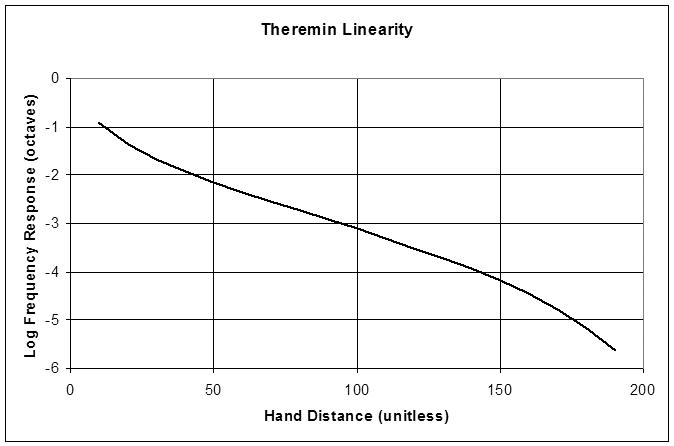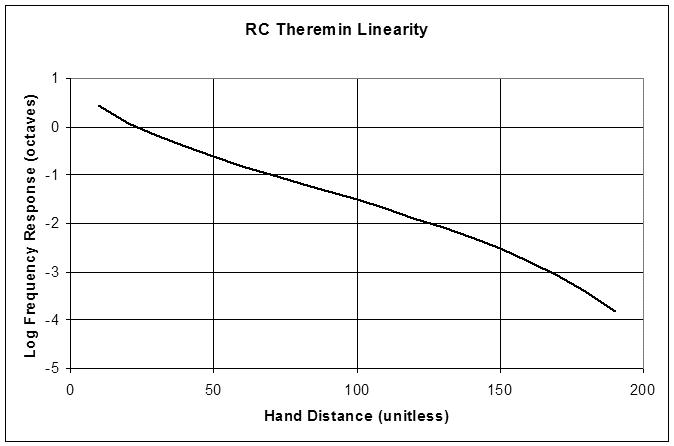Hi Roy,
Im not exactly sure what you mean by this question - Are you talking about a problem with a specific theremins antenna response being non-linear, or are you asking about the principle / theory underpinning linearity?
If the latter, I will give a brief "answer" now (but this will just skim the surface of this subject) - if you want more depth, just ask!
Ok, first lets discuss a theremin with no mechanism to improve linearity - What we have is a capacitance sensor (the antenna) and an oscillator whos frequency change is dependant on the change in capacitance "seen" by the antenna.
The capacitance change is a function of several things, one of these being the proximity of any conductive object which is in the circuit - for a theremin this is any object coupled to ground.. As the object approaches the antenna, the capacitance increases non-linearly (in fact its an inverse square law when moving away from the antenna, as in, capacitance decreases in an inverse of the square of the distance) - so one gets a dramatic increase in capacitance close to the antenna, and less rapid decrease as the object moves away from the antenna.
Our response to pitch change is exponential - Every raised octave constitutes a doubling of the frequency of the octave below it.. The reference oscillator is tuned to exploit the fact that capacitance increases non-linearly as the hand approaches the antenna - as in, it is tuned so that the (audio) difference frequency increases as the variable oscillator frequency decreases - and the variable oscillator frequency decreases as the antenna capacitance increases.. Thus the audio pitch (the difference between the variable and reference oscillator frequencies) increases as the hand approaches the antenna, and the rate of pitch increase also increases as the hand approaches the antenna..
However, for musical intervals, the inverse-square law is not correct - (the rate of pitch increase as the hand approaches the antenna is too great - causing compression of the playing area / notes at the high end, and expansion [widening] of the spacing of notes at the low end) , it is orders of magnitude better than if one had the pitch rising as one moved ones hand away from the antenna (such an arrangment is absolutely unworkable) but to get a reasonable number of playable octaves with evenly spaced musical intervals, one needs to "correct" the inverse-square relationship and turn it into an exponential relationship where the audio frequency doubles over a fixed distance of hand movement towards the antenna - and (for a perfect theremin - which does not, and probably cannot exist - at least not without active "intelligent" compensation) this fixed distance should be the same over the whole playing area.
{ The above is simplistic, because the oscillator frequency may not reflect capacitance exactly - there are different responses for different oscillator types - for example, an RC oscillator will relate directly (f = R*C) wheras a LC oscillator frequency could have a formula like f=1/(2pi(Sqrt(LC))) And I believe that the Sqrt function does improve the linearity - as in, its certainly better than an RC oscillator - }
To achieve this, a secondary resonant antenna circuit is added to most high-end theremins and even some not-so-high-end theremins. Thierry has given a brilliant explanation of this mechanism -
http://thereminworld.com/Forums/T/28530/antenna-tuning?Page=3
The above link is to 3 sequential posts by Thierry - I think there should be some "bookmark" for these posts, or that they should be copied into a reference document in the "tech + DIY" section of TW, as they are a masterpiece!
Fred.
Just to be pedantic (LOL - I must always introduce something pedantic ;-).. "Linearity" is a confusing and probably technically incorrect term for what we want.. We want "percieved linearity" - because we are intrinsically "non linear" in the way we percieve sound - both for pitch and for volume.



